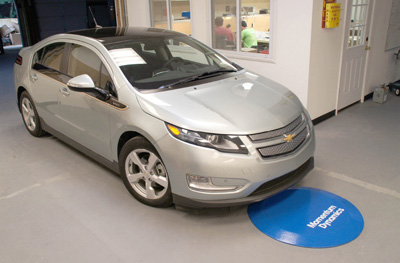— Do you think we should expect appearance of wireless charging stations for electric vehicles in Russia?
— We think that a wireless charging station is a very promising product, even for Russia. This technology makes electric car charging process much easier and “unnoticed” for a user. Besides, you must admit that it is much more convenient just to place your car above the charging station transmitter than to mess with massive and often dirty charging cables (taking into account the station is located outdoors).
Also, please note that wireless stations are not linked to a certain type of transport. Any existing electric vehicles (industrial electric cars, golf carts, electric forklifts, etc.) may be fitted with a set of respective equipment.
I think that in the future, wireless charging will be widely used for urban electric transport, and we are absolutely sure that such technology will find use in Russia as well.
 — What are restrictions and downsides of this technology?
— What are restrictions and downsides of this technology?
— Basically, engineers are now working on ensuring maximum safety of wireless charging stations for people and electronic devices in the immediate vicinity. A station transmits energy by means of high-frequency electromagnetic radiation, and even if its efficiency factor is about 90%, a powerful wireless charging station may emit a few kilowatts of radiation to the ambient environment.
The second issue that was faced by developers of wireless charging devices was how exposure to water, snow, dirt and foreign (especially metal) objects in between the transmitter and the receiver affects the station’s efficiency and operational safety. Also, there are restrictions in terms of a distance to which a station may transfer electromagnetic energy subject to maintaining high efficiency. The requirements to the accuracy of positioning of a transmitter and a receiver are very strict.
Fortunately, many of those problems are currently being solved, and now there are ready-to-use WCC commercial products with a capacity of a few kilowatts.
— In the long term, what prospects do you see for further WCC development? Will they be able to replace the other stations?
.jpg) — Capacity improvement and safety will be the main trends of development of wireless charging stations. In the long view, they will be widely used in public outdoor networks for charging electric cars thanks to their convenience. Also, I can see a great potential of wireless charging in the sector of urban, commercial, and industrial electric transportation, especially for those companies that do or will operate large transportation fleets.
— Capacity improvement and safety will be the main trends of development of wireless charging stations. In the long view, they will be widely used in public outdoor networks for charging electric cars thanks to their convenience. Also, I can see a great potential of wireless charging in the sector of urban, commercial, and industrial electric transportation, especially for those companies that do or will operate large transportation fleets.
Wireless charging stations will be installed not only at termini or overnight stations of vehicles but also at some stops along the route. Indeed, such kind of transport uses the same routes every day, and installation of wireless charging stations will be great for a quick recharge during those stops. And in the longer term, we will see wireless charging devices built right into the roadbed. They will charge electric vehicles on the move. Once this time comes, there will be no more need to “put the car on charge”: the vehicle will charge itself once going on the road.
Prepared by Kira Patrakova
For the picture: a wireless solution for ChevroletVolt
Photos by Momentum Dynamics Corporation (provided by the speaker)
(С) Медиапортал сообщества ТЭК www.EnergyLand.info
Оформить подписку на контент Looking for authoritative content?
Копирование без письменного разрешения редакции запрещено


